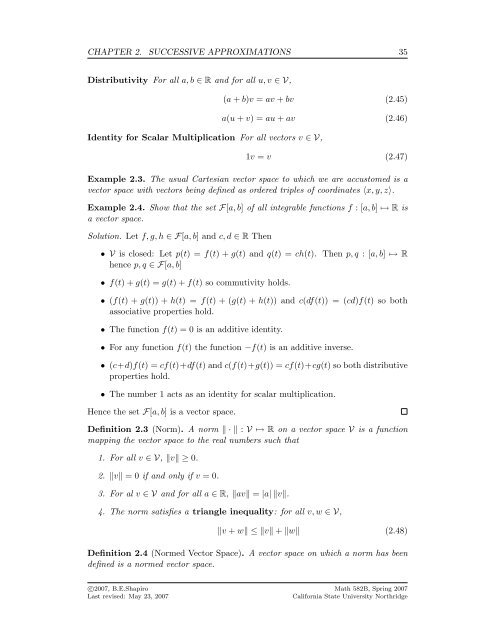The Computable Differential Equation Lecture ... - Bruce E. Shapiro
The Computable Differential Equation Lecture ... - Bruce E. Shapiro
The Computable Differential Equation Lecture ... - Bruce E. Shapiro
You also want an ePaper? Increase the reach of your titles
YUMPU automatically turns print PDFs into web optimized ePapers that Google loves.
CHAPTER 2. SUCCESSIVE APPROXIMATIONS 35<br />
Distributivity For all a, b ∈ R and for all u, v ∈ V,<br />
(a + b)v = av + bv (2.45)<br />
a(u + v) = au + av (2.46)<br />
Identity for Scalar Multiplication For all vectors v ∈ V,<br />
1v = v (2.47)<br />
Example 2.3. <strong>The</strong> usual Cartesian vector space to which we are accustomed is a<br />
vector space with vectors being defined as ordered triples of coordinates 〈x, y, z〉.<br />
Example 2.4. Show that the set F[a, b] of all integrable functions f : [a, b] ↦→ R is<br />
a vector space.<br />
Solution. Let f, g, h ∈ F[a, b] and c, d ∈ R <strong>The</strong>n<br />
• V is closed: Let p(t) = f(t) + g(t) and q(t) = ch(t). <strong>The</strong>n p, q : [a, b] ↦→ R<br />
hence p, q ∈ F[a, b]<br />
• f(t) + g(t) = g(t) + f(t) so commutivity holds.<br />
• (f(t) + g(t)) + h(t) = f(t) + (g(t) + h(t)) and c(df(t)) = (cd)f(t) so both<br />
associative properties hold.<br />
• <strong>The</strong> function f(t) = 0 is an additive identity.<br />
• For any function f(t) the function −f(t) is an additive inverse.<br />
• (c+d)f(t) = cf(t)+df(t) and c(f(t)+g(t)) = cf(t)+cg(t) so both distributive<br />
properties hold.<br />
• <strong>The</strong> number 1 acts as an identity for scalar multiplication.<br />
Hence the set F[a, b] is a vector space.<br />
Definition 2.3 (Norm). A norm ‖ · ‖ : V ↦→ R on a vector space V is a function<br />
mapping the vector space to the real numbers such that<br />
1. For all v ∈ V, ‖v‖ ≥ 0.<br />
2. ‖v‖ = 0 if and only if v = 0.<br />
3. For al v ∈ V and for all a ∈ R, ‖av‖ = |a| ‖v‖.<br />
4. <strong>The</strong> norm satisfies a triangle inequality: for all v, w ∈ V,<br />
‖v + w‖ ≤ ‖v‖ + ‖w‖ (2.48)<br />
Definition 2.4 (Normed Vector Space). A vector space on which a norm has been<br />
defined is a normed vector space.<br />
c○2007, B.E.<strong>Shapiro</strong><br />
Last revised: May 23, 2007<br />
Math 582B, Spring 2007<br />
California State University Northridge
















